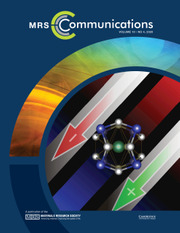Article contents
Electrochemical kinetics and dimensional considerations at the nanoscale: the influence of the density of states
Published online by Cambridge University Press: 14 September 2017
Abstract

The theories to describe the rate at which electrochemical reactions proceed do not consider explicitly the dimensionality or the occupancy of the energy levels of nanostructured electrodes. It is shown here that the density of states variation in nanoscale electrochemical systems yield novel modulations in the rate constant and concomitant electrical currents. The proposed models extend the utility of presently used Marcus–Hush–Chidsey kinetics to a larger class of materials and could be used as a test of dimensional character. The new models are applied to explain the experimental variation of the electrochemical rate constant of single-layer graphene.
Information
- Type
- Research Letters
- Information
- Copyright
- Copyright © Materials Research Society 2017
References
1.Kuznetsov, A.M.: Charge Transfer in Physics, Chemistry and Biology: Physical Mechanisms of Elementary Processes and an Introduction to the Theory (CRC Press, Boca Raton, FL, 1995).Google Scholar
2.Savéant, J.-M.: Elements of Molecular and Biomolecular Electrochemistry: An Electrochemical Approach to Electron Transfer Chemistry (John Wiley & Sons, Inc., New York, NY, 2006).Google Scholar
3.Yamada, H. and Bandaru, P.R.: Limits to the magnitude of capacitance in carbon nanotube array electrode based electrochemical capacitors. Appl. Phys. Lett. 102, 173113 (2013).Google Scholar
4.Yamada, H. and Bandaru, P.R.: Enhanced electrical current densities in electrochemical systems through the use of nanostructured electrodes. Appl. Phys. Lett. 104, 213901 (2014).Google Scholar
5.Linden, D. and Reddy, T.B.: Linden's Handbook of Batteries (McGraw Hill, New York, NY, 2010).Google Scholar
6.Bard, A.J. and Faulkner, L.R.: Electrochemical Methods: Fundamentals and Applications, 2nd ed. (John Wiley& Sons, Inc., New York, NY,2001).Google Scholar
7.Compton, R.G. and Banks, C.E.: Understanding Voltammetry (Imperial College Press, London, UK, 2011).Google Scholar
8.Marcus, R.A.: On the theory of oxidation-reduction reactions involving electron transfer. I. J. Chem. Phys. 24, 966 (1956).Google Scholar
9.Sutin, N.: Marcus’ contributions to electron-transfer theory. J. Phys. Chem. 90, 3465 (1986).Google Scholar
10.Hush, N.S.: Electron transfer in retrospect and prospect 1: adiabatic electrode processes. J. Electroanal. Chem. 470, 170 (1999).Google Scholar
11.Henstridge, M.C., Laborda, E., Rees, N.V., and Compton, R.G.: Marcus–Hush–Chidsey theory of electron transfer applied to voltammetry: a review. Electrochim. Acta 84, 12 (2012).Google Scholar
12.Chidsey, C.E.: Free energy and temperature dependence of electron transfer at the metal-electrolyte interface. Science 251, 919 (1991).Google Scholar
13.Grampp, G.: The marcus inverted region from theory to experiment. Angew. Chem. Int. Edn. 32, 691 (1993).Google Scholar
14.Miller, J.R., Calcaterra, L.T., and Closs, G.L.: Intramolecular long-distance electron transfer in radical anions. The effects of free energy and solvent on the reaction rates. J. Am. Chem. Soc. 106, 3047 (1984).Google Scholar
15.Fletcher, S.: The theory of electron transfer. J. Solid State Electrochem. 14, 705 (2010).Google Scholar
16.Li, T.T.T. and Weaver, M.J.: Intramolecular electron transfer at metal surfaces. 4. Dependence of tunneling probability upon donor-acceptor separation distance. J. Am. Chem. Soc. 106, 6107 (1984).Google Scholar
17.Bai, P. and Bazant, M.Z.: Charge transfer kinetics at the solid-solid interface in porous electrodes. Nat. Commun. 5, 3585 (2014).Google Scholar
18.Miller, J.R., Beitz, J.V., and Huddleston, R.K.: Effect of free energy on rates of electron transfer between molecules. J. Am. Chem. Soc. 106, 5057 (1984).Google Scholar
19.Narayanan, R., Yamada, H., Karakaya, M., Podila, R., Rao, A.M., and Bandaru, P.R.: Modulation of the electrostatic and quantum capacitances of few layered graphenes through plasma processing. Nano Lett. 15, 3067 (2015).Google Scholar
20.Zhang, Y., Tan, Y.-W., Stormer, H.L., and Kim, P.: Experimental observation of the quantum Hall effect and Berry's phase in graphene. Nature 438, 201 (2005).Google Scholar
21.Das Sharma, S., Adam, S., Hwang, E.H., and Rossi, E.: Electronic transport in two-dimensional graphene. Rev. Mod. Phys. 83, 407 (2011).Google Scholar
22.Zhu, W., Low, T., Perebeinos, V., Bol, A.A., Zhu, Y., Yan, H., Tersoff, J., and Avouris, P.: Structure and electronic transport in graphene wrinkles. Nano Lett. 12, 3431 (2012).Google Scholar
23.Ambrosi, A., Chua, C.K., Bonanni, A., and Pumera, M.: Electrochemistry of graphene and related materials. Chem. Rev. 114, 7150 (2014).Google Scholar
24.Zaretski, A.V., Moetazedi, H., Kong, C., Sawyer, E.J., Savagatrup, S., Valle, E., O'Connor, T.F., Printz, A.D., and Lipomi, D.J.: Metal-assisted exfoliation (MAE): green, roll-to-roll compatible method for transferring graphene to flexible substrates. Nanotechnology 26, 45301 (2015).Google Scholar
25.Velicky, M., Bradley, D.F., Cooper, A.J., Hill, E.W., Kinloch, I.A., Mishchenko, A., Novoselov, K.S., PAtten, H.V., Toth, P.S., Valota, A.T., Worrall, S.D., and Dryfe, R.A.W.: Electron transfer kinetics on mono-and multilayer graphene. ACS Nano 8, 10089 (2014).Google Scholar
26.Yamada, H. and Bandaru, P.R.: Electrochemical kinetics and dimensional considerations, at the nanoscale. AIP Adv. 6, 65325 (2016).Google Scholar
27.Gerischer, H.: Principles of electrochemistry. In CRC Handb. Solid State Electrochem, edited by Gellings, P. J. and Bouwmeester, H. J. M. (CRC Press, Boca Raton, FL, 1997), pp. 9–74.Google Scholar
28.Martin, J., Akerman, N., Ulbricht, G., Lohmann, T., Smet, J.H., von Klitzing, K., and Yacoby, A.: Observation of electron–hole puddles in graphene using a scanning single-electron transistor. Nat. Phys. 4, 144 (2008).Google Scholar
29.Xia, J., Chen, F., Li, J., and Tao, N.: Measurement of the quantum capacitance of graphene. Nat. Nanotechnol. 4, 505 (2009).Google Scholar
30.Park, B.Y., Zaouk, R., Wang, C., and Madou, M.J.: A case for fractal electrodes in electrochemical applications. J. Electrochem. Soc. 154, P1 (2007).Google Scholar
- 3
- Cited by

